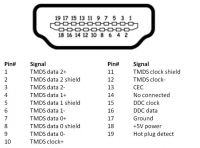Hello!
Below is a list of HDMI connectors.
Generally, I would like to make a printed circuit board on which there would be two HDMI connectors (pin in pin), and thanks to which after giving the appropriate control signal I would get the "black screen" effect.
The question is, which pins would I have to break (e.g. a small mosfet) so that the TV screen was only a black picture without sound?
The black image can very well be understood as an image with information about the lack of a signal.
Will 5 V (18 pin) signal disconnection get this effect?

Below is a list of HDMI connectors.
Generally, I would like to make a printed circuit board on which there would be two HDMI connectors (pin in pin), and thanks to which after giving the appropriate control signal I would get the "black screen" effect.
The question is, which pins would I have to break (e.g. a small mosfet) so that the TV screen was only a black picture without sound?
The black image can very well be understood as an image with information about the lack of a signal.
Will 5 V (18 pin) signal disconnection get this effect?



